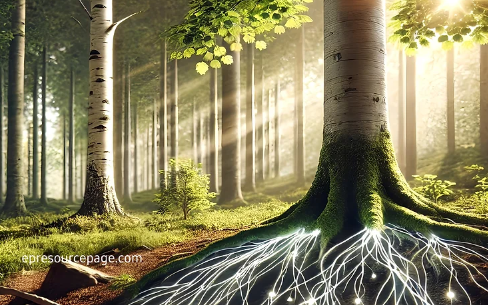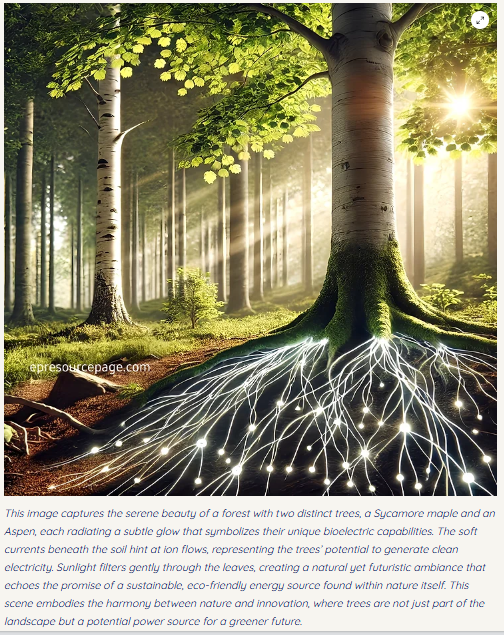Environment
Trees as Power Plants? The Potential of Bioelectricity from Nature


Imagine walking through a forest where the trees not only provide fresh air and a sense of tranquility but also serve as tiny power plants, generating clean electricity. It sounds like something out of science fiction, but recent research is bringing us closer to a reality where trees might become a sustainable energy source.
Scientists have discovered two tree species with the potential to generate electricity, sparking interest as a natural solution to our growing energy needs. Let’s dive into the science behind these “electric trees,” their environmental impact, and what this innovation could mean for the future of clean energy.
The Science Behind Electricity-Generating Trees
The journey to discovering electricity-generating trees began with studies into plant-soil interactions, specifically focusing on how ion flow and bioelectrochemical processes within plant tissues create small electric charges. Certain tree species naturally produce slight electric charges, similar to bioelectric processes in the human body.
These trees can release ions as water moves from their roots through their trunks. Through a series of chemical reactions, these ions generate a measurable electric charge. Researchers are now working on methods to collect this bioelectricity and turn it into usable power.
The Two Power-Producing Tree Species
The two tree species at the center of this research are Acer pseudoplatanus (commonly known as the Sycamore maple) and Populus tremula (Aspen tree). Each of these trees has unique characteristics that contribute to their bioelectric properties:
1. Sycamore Maple (Acer pseudoplatanus): Known for its broad leaves and adaptability to various climates, the Sycamore maple has a unique cellular structure that enhances ion flow, allowing it to generate small electrical currents.
2. Aspen Tree (Populus tremula): Commonly found in colder regions, Aspens are known for their rapid growth and extensive root systems. Their roots interact efficiently with the soil, producing ions that contribute to their electrical potential.
How Bioelectric Trees Could Benefit the Environment
Using trees to generate electricity offers numerous environmental benefits. Unlike traditional energy sources, bioelectricity from trees is entirely renewable and does not produce harmful emissions. Here are a few ways these electric trees could contribute to a sustainable future:
Carbon-Free Energy: Trees already play a critical role in absorbing carbon dioxide. Generating electricity in addition to carbon absorption could significantly offset emissions by reducing reliance on fossil fuels.
Minimal Land Use: Unlike solar panels or wind turbines, which require dedicated land, electricity-generating trees can be grown naturally, preserving biodiversity while producing power.
Cost-Effective for Remote Areas: Bioelectric trees could offer a low-cost, low-impact energy solution in areas without access to conventional electricity for basic needs like lighting, communication, and small appliances.
Challenges and the Road Ahead
Though promising, bioelectric trees face challenges before widespread use. A single tree’s electricity output remains low, and scaling up to power homes or industries will require advancements in bioengineering and technology. Future research will likely focus on hybrid approaches, combining bioelectricity from trees with other renewable sources, and enhancing electrical output through genetic or environmental modifications.
Looking Forward: Trees as Part of a Sustainable Energy Future
While we may be years away from forests powering cities, the discovery of electricity-generating trees is a testament to nature’s untapped potential. With ongoing research, trees like the Sycamore maple and Aspen could play a valuable role in the green energy movement. Alongside solar, wind, and other renewables, bioelectricity from trees may one day become part of an innovative, multi-source approach to achieving carbon neutrality.
Further Reading and Resources
To learn more about this exciting discovery, here are some helpful resources:
1. National Geographic – Trees with Electrical Potential
2. Nature Journal – Bioelectricity in Plants
3. Scientific American – Future of Bioelectric Energy
4. GreenTech Media – Innovations in Renewable Energy
Read more >> Blog | EP Resource Page, or search for more interesting or related blogs.
About the Author

Edwin Paña '69
Edwin O. Paña '69 is a multifaceted professional with a diverse academic foundation in Forestry and Business Administration. As a retired entrepreneur, he has successfully led multiple ventures throughout his career. In 2024, he was honored with the prestigious Tanglaw Award for Leadership, a testament to his dedicated service as Board Chairman of Upsilon Sigma Phi North America, Inc., where he contributed over a decade of impactful leadership.


